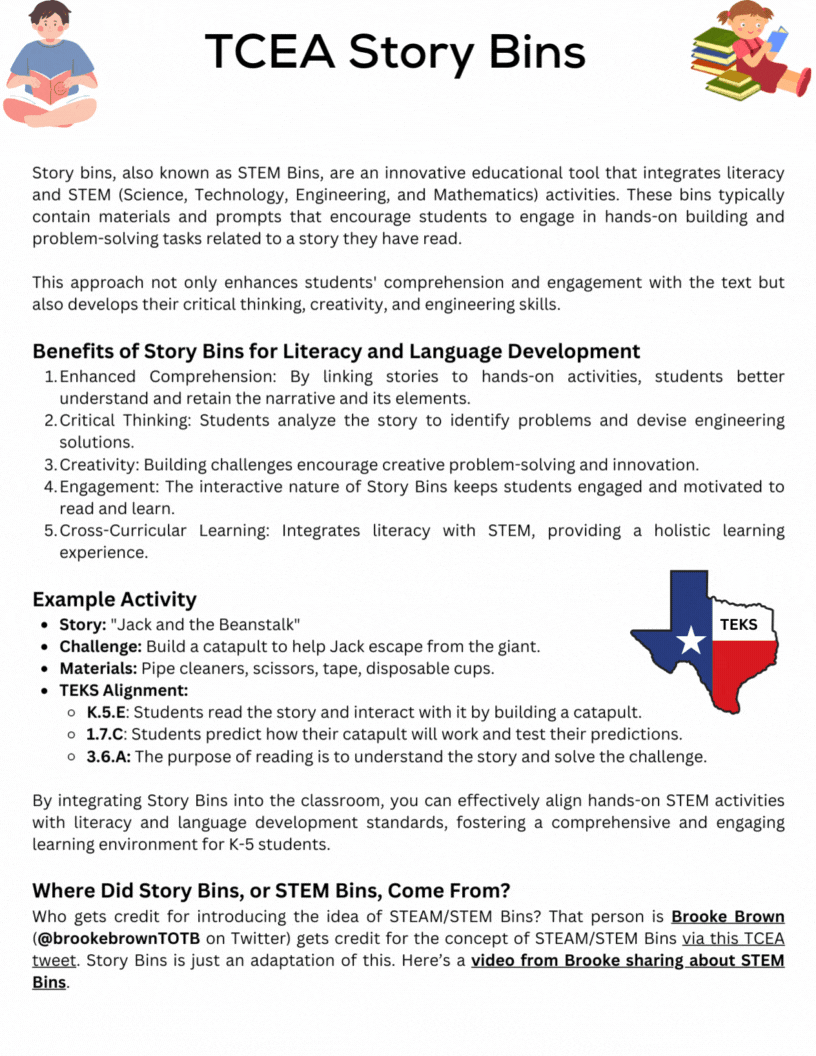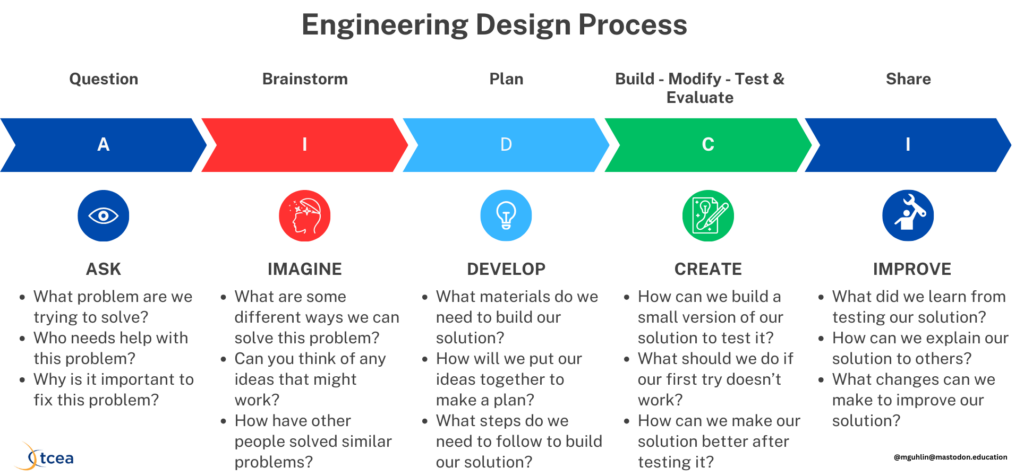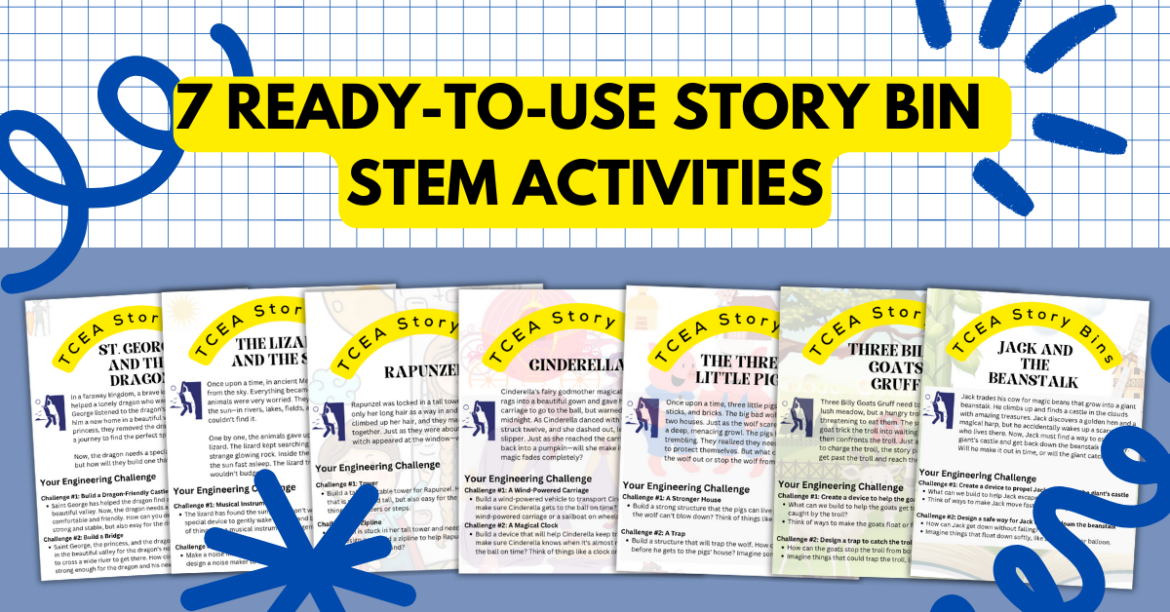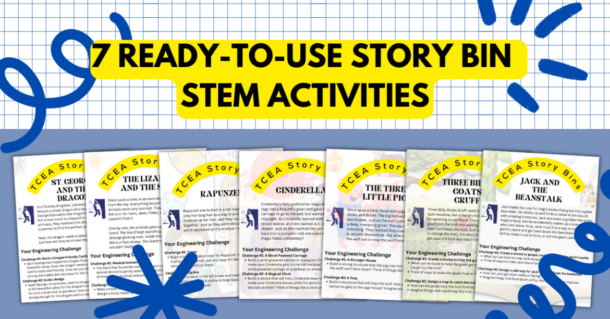“Have you heard of STEM Bins?” Peggy Reimers said. “No, I haven’t,” I replied. In a moment, I’d fallen off the plank, submerged into a sea of learning. Like treasure chests filled with tools for creative imagineering, STEM Bins are fun. I like to think of them as Story Bins, because they turn stories into powerful learning opportunities. Let’s explore several practical ideas for elementary Story Bins.
Brooke Brown (follow her on Twitter for more exciting ideas!) gets credit for introducing me to the concept of STEAM/STEM Bins via this 2024 tweet by TCEA. Story Bins are just an adaptation of this. Here’s a video from Brooke sharing about STEM Bins. What an amazing idea to add to your repertoire!
What Are Story Bins?
“Every child is an artist. The problem is how to remain an artist once we grow up.” – Pablo Picasso
Story Bins are containers filled with various materials. They start with a story, then provide a challenge. The challenge is to build something that helps a character in the story.
These are perfect for students in elementary grades. Meeting the challenge pushes students to think outside the bin. Even better, they can learn hands-on skills through their constructions.

Why Use Story Bins?
“Tell me and I forget, teach me and I may remember, involve me and I learn.” – Benjamin Franklin
With these bins of imagination, treasure chests of creativity, students blend their learning. You can also incorporate critical thinking skills a la Engineering Design Process.
Example: Jack and the Beanstalk
Take this old favorite tale. How would you build a catapult to escape the giant? The goal is to help Jack, who has to flee from a giant. A question to ask is, “How can we engineer a catapult using materials like pipe cleaners, scissors, tape, and disposable cups to help Jack escape from the giant’s castle in the clouds?”
The hands-on aspect of Story Bins makes it easy to connect knowledge to the real-world. In developing solutions that work, students solve problems that feel real to them. Tapping into various modalities can assist students’ brain in remembering concepts.
Some more questions for different stories are available via this link. Stories include:
- Alice in Wonderland
- Cinderella
- Hansel and Gretel
- Jack and Jill
- Jack and the Beanstalk
- Little Red Riding Hood
- Pinocchio
- Rapunzel
- Rumpelstiltskin
- Santa Claus
- Sleeping Beauty
- The Elves and the Shoemaker
- The Lion and the Mouse
- The Three Little Pigs
- The Ugly Duckling
- Three Billy Goats Gruff
An Example Story Bin Using the Engineering Design Process
In her blog entry, The Engineering Design Process for the Elementary Student, my colleague Peggy Reimers shares the Whirli-bots Engineering Design Process. Below, please find an adaptation of the Engineering Design Process. What if you ran one of the story bin challenges through this process?

The result might be something like what appears below. Let’s focus on another “Jack and the Beanstalk” idea. What’s my fixation with “Jack and the Beanstalk”? This was one of the stories I first read in Spanish, then later in English when I was growing up.
Challenge: Create a parachute to safely transport Jack down the beanstalk.
Before beginning, you might first consider some guiding questions for the Engineering Design Process. Now that the challenge is set, let’s think through what it might look like in action.
1. Ask (Define the Problem)
- Problem: Jack needs to escape from the giant’s castle safely.
- Criteria: The parachute must slow Jack’s descent.
- Constraints: Use available materials (pipe cleaners, scissors, tape, disposable cups).
2. Imagine (Brainstorm Solutions)
Ideas:
- Use a large piece of lightweight material (e.g., tissue paper or plastic bag) as the parachute canopy.
- Attach strings to the corners of the canopy and connect them to a small cup that represents Jack.
- Ensure the parachute is large enough to create enough air resistance.
3. Plan (Develop the Solution)
Materials Needed:
- Tissue paper or plastic bag
- String
- Disposable cup
- Tape
- Scissors
Design:
- Cut a large square from the tissue paper or plastic bag.
- Attach strings to the corners of the square.
- Connect the other ends of the strings to the cup.
Steps:
- Cut the canopy material into a square.
- Reinforce the corners with tape and punch holes.
- Cut four equal lengths of string and tie them to the corners.
- Attach the other ends of the strings to the cup.
4. Create (Build, Modify, Test & Evaluate)
Build:
- Assemble the parachute as planned.
Test:
- Drop the parachute from a height and observe its performance.
Evaluate:
- Check if the parachute slows the descent effectively.
- Note any issues, such as the parachute not opening fully or the descent being too fast.
Modify:
- Adjust the size of the canopy or the length of the strings if needed.
- Test again to see if the modifications improve performance.
5. Improve (Share)
Learnings:
- Document what worked well and what didn’t.
- Share the design and test results with classmates or teachers.
Improvements:
- Based on feedback, make further adjustments to the parachute design.
- Consider using different materials. Or change the shape of the canopy for better results.
More Engineering Design Process Story Bin Ideas
Here’s another Engineering Design Process you might find useful for younger students. How would you do it?
| Story | Challenge | Question | Brainstorm | Plan | Build (Test & Evaluate, Modify) | Share |
|---|---|---|---|---|---|---|
| Jack and the Beanstalk | Create a device to propel Jack away from the giant’s castle | What can we build to help Jack escape? | Think of ways to make Jack move fast, like a slingshot or a rocket. | Draw a picture of our idea and list what we need. | Make our escape gadget, try it out, and change it if we need to. | Show our friends and explain how it works. |
| Jack and the Beanstalk | Design a safe way for Jack to come down the beanstalk | How can Jack get down without falling? | Imagine things that float down softly, like parachutes or balloons. | Choose the best idea and plan how to make it. | Create our parachute, drop it from up high, and make it better. | Share our parachute and tell others how we made it safe for Jack. |
| Three Billy Goats Gruff | Build a raft for the goats to cross the river | Can we make a raft that holds all three goats? | Think of floaty things like logs or big tubes. | Pick the floatiest idea and plan how to tie them together. | Build our raft, test it in water, and fix anything that’s not right. | Show our raft and tell the story of how the goats used it. |
How Do Story Bins Enhance Education?
“Simplicity is the ultimate sophistication.” – Leonardo da Vinci
Put Story Bins into the classroom to get the benefits for students. Those benefits include:
- Have students who finish assignments early? Use Story Bins as a way to keep them involved and learning.
- Need sponge activities for morning work or centers? Maybe you have a need to keep kids as a time-out/cool-down area engaged. Use Story Bins for that, too.
- Focused on a particular story? Use Story Bins to explore various parts of the story.
Science is often under-utilized but processes like the Engineering Design Process (EDP) help. They model scientific thinking where students develop a hypothesis, gather evidence through prototyping. Then, they test their hypotheses to see if they are falsifiable (if the work or not).
Examples of STEAM Story Bin Challenges
“Imagination is everything. It is the preview of life’s coming attractions.”- Albert Einstein
Here are a few ideas for Story Bins using common stories with a STEAM twist. You will find an AI-generated list of stories, challenges, and materials.
My colleague, Peggy Reimers, suggested the materials area include reusable materials, as well. Take a look at what’s available in your classroom, at home, and add to the list of one-time use materials, too.
| Story | The Challenge | One-Time Use Materials | Suggested Reusable Materials |
|---|---|---|---|
| Jack and the Beanstalk | Design a catapult to help Jack escape the giant. | Popsicle sticks, rubber bands, plastic spoon | Keva Planks, rubber bands |
| Jack and the Beanstalk | Create a parachute to safely transport Jack down the beanstalk. | Lightweight fabric or a plastic bag, string, small toy figure | Lightweight fabric, string, LEGO figurine |
| Three Billy Goats Gruff | Build a raft to help the Billy Goats Gruff cross the river. | Corks, popsicle sticks, rubber bands, small plastic figures | Strawbees, foam pieces, small LEGO figures |
| Jack and Jill | Construct a pulley system to lift the pails for Jack and Jill. | String, spools, paper cups | LEGO bricks, string, small buckets (LEGO pieces) |
| The Three Little Pigs | Engineer a stronger house for the Three Little Pigs using different materials. | Straws, craft sticks, clay, cardboard | Lincoln Logs, LEGO bricks |
| The Three Little Pigs | Design a trap to catch the Big Bad Wolf. | Cardboard boxes, rubber bands, plastic bottle caps | LEGO bricks, rubber bands |
| Three Billy Goats Gruff | Build a bridge that can support the weight of the Troll. | Popsicle sticks, glue, string, small weights like coins | Keva Planks, glue (if permanent), weights (coins or small stones) |
| Little Red Riding Hood | Create a zip line to help Little Red Riding Hood escape the woods quickly. | String, straw, paper clip, small toy figure | String, straw (from Strawbees), paper clip, LEGO figurine |
| Hansel and Gretel | Construct a marble run for Hansel and Gretel to find their way out of the forest. | Cardboard tubes, marbles, tape | Keva Planks, marbles |
| The Ugly Duckling | Build a boat that floats for The Ugly Duckling. | Corks, plastic spoons, waterproof tape | Strawbees, waterproof material (cut from reusable shopping bags), small LEGO figure |
| Rapunzel | Design a tower that won’t fall down for Rapunzel’s prince to climb. | Cardboard, tape, paper tubes | Keva Planks, LEGO bricks |
| The Elves and the Shoemaker | Create a simple machine to help the Elves make toys faster. | Gears, wooden skewers, rubber bands | LEGO gears, wooden skewers, rubber bands |
| Santa Claus | Build a prototype of Santa’s sleigh with working runners. | Ice pop sticks, cardboard, fabric scraps | Keva Planks, fabric scraps |
| The Elves and the Shoemaker | Engineer a contraption to help the Shoemaker work more efficiently. | Cardboard, scissors, glue, fabric scraps | LEGO bricks, gears |
| Sleeping Beauty | Design a device to help Sleeping Beauty’s fairy godmothers travel faster. | Balloons, straws, rubber bands, small toy figures | Balloons, Strawbees, rubber bands, LEGO figures |
| Cinderella | Construct a vehicle powered by wind to transport Cinderella to the ball. | Cardboard, paper, straws, balloons | LEGO bricks, paper (for sails), straws |
| The Lion and The Mouse | Build a seesaw for the characters from The Lion and The Mouse. | Popsicle sticks, plastic spoon, small toy figures | Keva Planks, plastic spoon (as a fulcrum), LEGO figures |
| Pinocchio | Create a toy car for Pinocchio that moves using rubber bands. | Cardboard, rubber bands, bottle caps for wheels | LEGO bricks, rubber bands, bottle caps (for wheels) |
| Alice in Wonderland | Design a contraption to help Alice get back up the rabbit hole. | Cardboard tubes, string, pulleys | Keva Planks, string, pulleys (LEGO or similar) |
| Rumpelstiltskin | Build a spinning wheel that can wind up the golden thread. | Cardboard, dowels, string | Keva Planks, dowels, string |
Additional STEM Resources for Story Bins
You can find a wealth of resources for Story Bins online. Here are a few curated links for your consideration. They may ignite your own passion and learning, as they did me.
- STEM Bins and STEAM Bins via Brooke Brown, Teacher Pay Teachers
- STEAM Bins from Teach Outside the Box
- STEM Bins via Hand2Mind
Which Story Bin activity will you try with your students? Have ideas for other Story Bin STEM activities? Leave us a comment so we can add it to the list!


